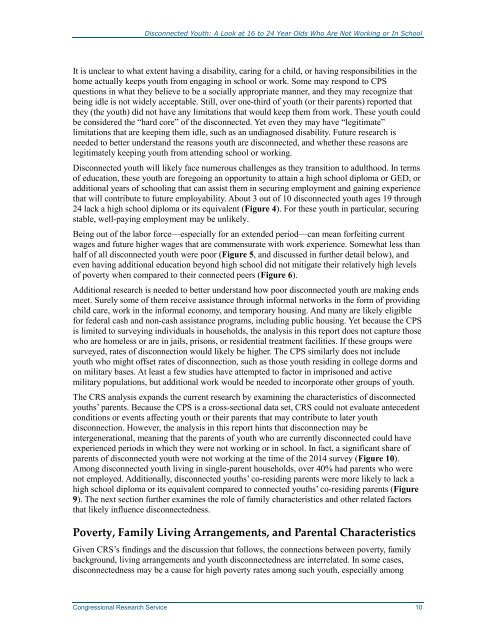Opportunity Youth: Disenfranchised Young People
Opportunity Youth: Disenfranchised Young People
Opportunity Youth: Disenfranchised Young People
Create successful ePaper yourself
Turn your PDF publications into a flip-book with our unique Google optimized e-Paper software.
Disconnected <strong>Youth</strong>: A Look at 16 to 24 Year Olds Who Are Not Working or In School<br />
It is unclear to what extent having a disability, caring for a child, or having responsibilities in the<br />
home actually keeps youth from engaging in school or work. Some may respond to CPS<br />
questions in what they believe to be a socially appropriate manner, and they may recognize that<br />
being idle is not widely acceptable. Still, over one-third of youth (or their parents) reported that<br />
they (the youth) did not have any limitations that would keep them from work. These youth could<br />
be considered the “hard core” of the disconnected. Yet even they may have “legitimate”<br />
limitations that are keeping them idle, such as an undiagnosed disability. Future research is<br />
needed to better understand the reasons youth are disconnected, and whether these reasons are<br />
legitimately keeping youth from attending school or working.<br />
Disconnected youth will likely face numerous challenges as they transition to adulthood. In terms<br />
of education, these youth are foregoing an opportunity to attain a high school diploma or GED, or<br />
additional years of schooling that can assist them in securing employment and gaining experience<br />
that will contribute to future employability. About 3 out of 10 disconnected youth ages 19 through<br />
24 lack a high school diploma or its equivalent (Figure 4). For these youth in particular, securing<br />
stable, well-paying employment may be unlikely.<br />
Being out of the labor force—especially for an extended period—can mean forfeiting current<br />
wages and future higher wages that are commensurate with work experience. Somewhat less than<br />
half of all disconnected youth were poor (Figure 5, and discussed in further detail below), and<br />
even having additional education beyond high school did not mitigate their relatively high levels<br />
of poverty when compared to their connected peers (Figure 6).<br />
Additional research is needed to better understand how poor disconnected youth are making ends<br />
meet. Surely some of them receive assistance through informal networks in the form of providing<br />
child care, work in the informal economy, and temporary housing. And many are likely eligible<br />
for federal cash and non-cash assistance programs, including public housing. Yet because the CPS<br />
is limited to surveying individuals in households, the analysis in this report does not capture those<br />
who are homeless or are in jails, prisons, or residential treatment facilities. If these groups were<br />
surveyed, rates of disconnection would likely be higher. The CPS similarly does not include<br />
youth who might offset rates of disconnection, such as those youth residing in college dorms and<br />
on military bases. At least a few studies have attempted to factor in imprisoned and active<br />
military populations, but additional work would be needed to incorporate other groups of youth.<br />
The CRS analysis expands the current research by examining the characteristics of disconnected<br />
youths’ parents. Because the CPS is a cross-sectional data set, CRS could not evaluate antecedent<br />
conditions or events affecting youth or their parents that may contribute to later youth<br />
disconnection. However, the analysis in this report hints that disconnection may be<br />
intergenerational, meaning that the parents of youth who are currently disconnected could have<br />
experienced periods in which they were not working or in school. In fact, a significant share of<br />
parents of disconnected youth were not working at the time of the 2014 survey (Figure 10).<br />
Among disconnected youth living in single-parent households, over 40% had parents who were<br />
not employed. Additionally, disconnected youths’ co-residing parents were more likely to lack a<br />
high school diploma or its equivalent compared to connected youths’ co-residing parents (Figure<br />
9). The next section further examines the role of family characteristics and other related factors<br />
that likely influence disconnectedness.<br />
Poverty, Family Living Arrangements, and Parental Characteristics<br />
Given CRS’s findings and the discussion that follows, the connections between poverty, family<br />
background, living arrangements and youth disconnectedness are interrelated. In some cases,<br />
disconnectedness may be a cause for high poverty rates among such youth, especially among<br />
Congressional Research Service 10

















